Google Forms is one of the most popular online form builders available. It’s 100% free, forever, very beginner-friendly and easy to use, and fast to set up. However, Google Forms has significant limitations in design and functionality. Here are the best Google Forms alternatives ⇣ that offer enhanced features and greater flexibility.
While Google Forms is an excellent free option for basic form creation, its simplicity can be a drawback for more complex needs. In my experience, investing a small amount monthly in a premium form builder can dramatically improve your form’s effectiveness and user experience.
Quick summary:
- Best overall: Typeform ⇣ After testing numerous form builders, I’ve found Typeform to be the most versatile. Its design tools are top-notch, and the user interface is incredibly intuitive, making form creation a breeze.
- Best design alternative: JotForm ⇣ For those prioritizing design flexibility, JotForm stands out. I’ve created visually stunning forms with JotForm that significantly boosted engagement rates.
- Best budget-friendly alternative: Wufoo ⇣ In my comparisons, Wufoo consistently offers the best value for money. It provides robust features at a fraction of the cost of some competitors.
- Best WordPress alternative: WPForms ⇣ As a WordPress user, I’ve tried numerous form plugins, and WPForms is unquestionably the leader. Its seamless integration and powerful features make it indispensable for WordPress sites.
While Google Forms has its merits, its limitations become apparent when you need more advanced features. In my work with clients across various industries, I’ve consistently found that Google Forms falls short for anything beyond the most basic surveys or contact forms.
The form builder market offers a wealth of alternatives that can cater to more specific needs and complex use cases.
Many of these Google Forms alternatives are already widely adopted, but I’ve also discovered some hidden gems that are gaining traction rapidly. These emerging options often combine innovative features with user-friendly interfaces, addressing common pain points in form creation and management.
Top Google Forms Alternatives in 2025
If you’re looking for a Google Form alternative with more advanced features and customization options, there are several options available to choose from. One of the top alternatives is Cognito Forms, which offers a wide range of form-building features, including payment fields, registration forms, and more.
Another solid option is JotForm Enterprise, which is specifically designed for larger organizations and businesses. Zoho CRM is also a great choice for those who need a comprehensive customer relationship management tool.
For a freemium survey tool, consider checking out add-ons like Google Forms. And if you need payment services, look into freemium survey tools like Cognito Forms and JotForm Enterprise that offer payment integration capabilities.
Overall, the best Google Forms alternatives are Typeform (best overall), Wufoo (best cheap alternative), JotForm (best for advanced designs), and WPForms (best for WordPress).
1. Typeform (best alternative)
- Website: https://www.typeform.com
- Extremely versatile, customizable forms
- A range of attractive templates
- Interactive form designer

Typeform is one of the best Google Forms alternatives I’ve used. It’s an extremely powerful platform that lets you create basically any type of form you want.
The form designer is super flexible, and there are numerous templates that you can use to get started.

On top of this, you can integrate your Typeform forms with a selection of third-party platforms, including Slack, MailChimp, Google Sheets, and more.
There’s even a basic free plan that you can use to familiarize yourself with the platform, which is something I like to see.
Typeform pros:
- Great range of attractive templates
- Logical form designer
- Integrations with numerous platforms
Typeform cons:
- Quite expensive compared to some other platforms
- Could be a little over the top for some users
- Sub-par customer service
Typeform pricing plans:
Typeform offers three paid and one free forever plans. Prices start from $25 per month with a yearly subscription.
Discounts are available with annual subscriptions, and custom solutions are available for large businesses.
| Essentials | $25/month |
| Professional | $50/month |
| Premium | $83/month |
Typeform vs Google Forms:
Typeform offers some of the best design flexibility I’ve seen among popular form builders.
If you want to create a highly customized form, I’d highly recommend considering this Google Forms competitor.
2. JotForm (best design alternative)
- Website: https://www.jotform.com
- Highly customizable form templates
- Allows you to integrate powerful functionality
- Various task automation features
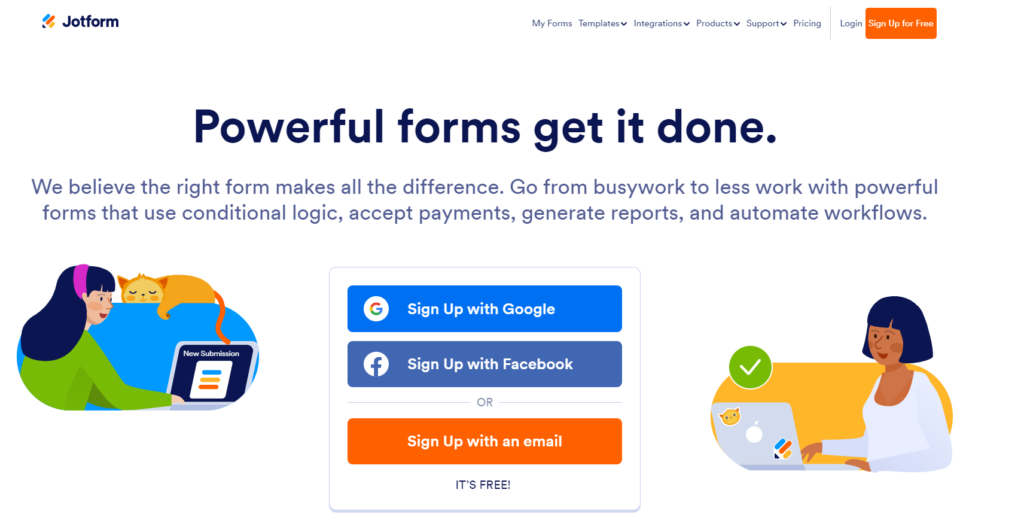
Like Typeform, JotForm is a highly-advanced form creation platform that prioritizes design flexibility and powerful integrations.
There are numerous templates available, and the drag-and-drop designer means that you will virtually only be limited by your imagination.

One thing that stood out about JotForms was its payment acceptance integrations. Unlike many competitors, it actually lets you collect payments directly through the form itself.
Popular templates include options for recurring subscriptions, online orders, and donations.
JotForm pros:
- Accept online payments
- Drag-and-drop interface
- Excellent design and template libraries
JotForm cons:
- Can’t customize based on form responses
- Selecting a template can be difficult
- Customer support is average at best
JotForm pricing plans:
JotForm uses a recurring, subscription-based payment model.
There’s a fully-functional free plan (with a five-form limit) that you can use to test the platform, and there’s even a comprehensive 30-day money-back guarantee if you change your mind following a purchase.
There are three paid plans available, which start from $34 per month with an annual subscription). All have forms, monthly submissions, and storage limits.
| Bronze | $29/month |
| Silver | $39/month |
| Gold | $99/month |
JotForm vs Google Forms:
JotForm’s drag-and-drop builder, excellent template library, and other design options make it a great choice for those who find Google Forms just a little too simple.
3. Wufoo (best cheap alternative)
- Website: https://www.wufoo.com
- Competitively priced alternative
- Very flexible
- Comes with various workflow automation tools
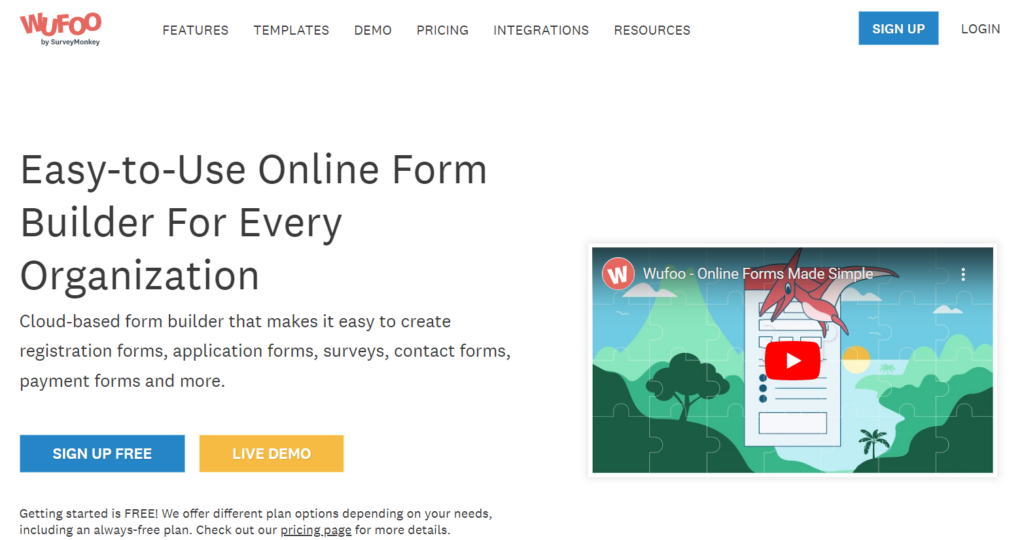
Wufoo is one of my favorite alternatives to Google Forms, and for good reason.
It’s much more affordable than many of the other options on this list, offers excellent functionality, and uses highly-secure cloud storage to ensure any collected data is safe at all times.
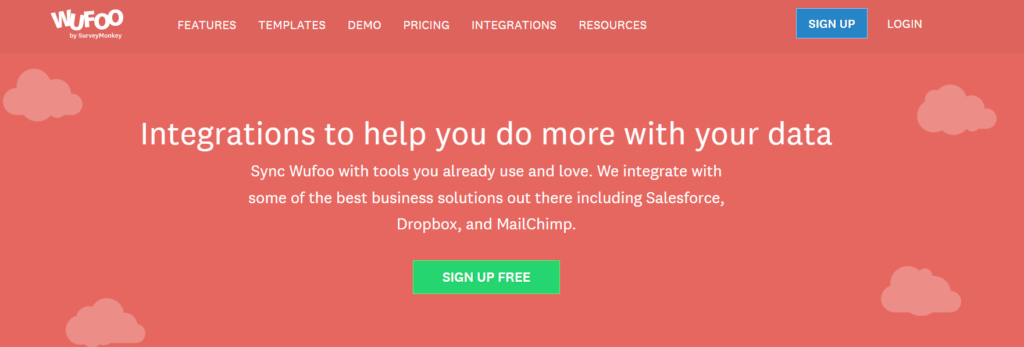
One thing I love is Wufoo’s support for virtually any type of information.
You can integrate your form with your chosen payment provider to accept payments, ask people to upload files where required, and more.
There are also numerous integrations and tools to help you automate workflows.
Wufoo pros:
- Excellent workflow automation tools
- Collect numerous types of information
- Analyze your data with custom reports
Wufoo cons:
- The user interface is a little confusing
- Can be hard to get the hang of
- Some limitations on the amount of info you can collect
Wufoo pricing plans:
There are four paid plans alongside a basic free forever option.
Prices start from $14 per month, with a 25% discount available for annual subscriptions.
| Starter | $19/month |
| Professional | $39/month |
| Advanced | $99/month |
| Ultimate | $249/month |
Why Wufoo is a good alternative to Google Forms:
WuFoo is my favorite cheap alternative to Google Forms. Sure, it’s still quite costly, but it’s significantly more affordable than most similar competitors.
4. WPForms (best WordPress alternative)
- Website: https://wpforms.com
- A great option for WordPress users
- Highly advanced WordPress-specific features
- Supports fast creation of complex forms

If you’re looking for an extremely powerful WordPress form builder, you just can’t go past WPForms.
This powerful plugin is backed by a suite of advanced features, allowing you to create everything from simple contact forms to polls and surveys, and payment forms.

In addition, there are countless features that you can use to improve the functionality of your form.
Get instant notifications, create mobile-responsive forms, accept file uploads if required, and take advantage of the drag and drop form interface.
WPForms pros:
- Excellent range of advanced features
- Integrate directly with your WordPress website
- Smart workflows to aid complex form building
- Allows you to create unlimited forms
WPForms cons:
- Have to use expensive plans to unlock some features
- Designed specifically for WordPress sites
- Customization can be limited at times
WPForms pricing plans:
WPForms is quite an affordable option, with prices for its four plans starting from $49.50 per year.
However, prices do double on renewal, and there isn’t any free plan or free trial available.
| Basic | $39.50/year |
| Plus | $99.50/year |
| Pro | $199.50/year |
| Elite | $299.50/year |
Why WPForms is a good Google Forms alternative:
I’ve tested countless options, and I can comfortably say that WPForms is the best WordPress forms plugin I’ve found.
The range of advanced features combined with the relatively low price point makes it an extremely attractive proposition.
5. Gravity Forms
- Website: https://www.gravityforms.com
- Straightforward WordPress form builder
- Simple, beginner-friendly form building
- Integrations with numerous third-party platforms
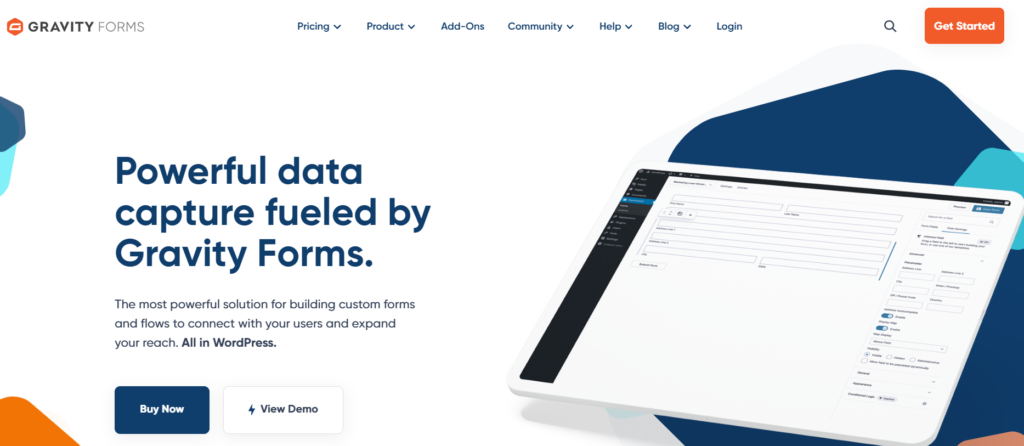
Another one of my favorite WordPress plugins is Gravity Forms.
Although the WordPress plugin industry is a ruthless place, this popular choice has remained a leader for more than ten years – which tells me that it just has to be a great option.
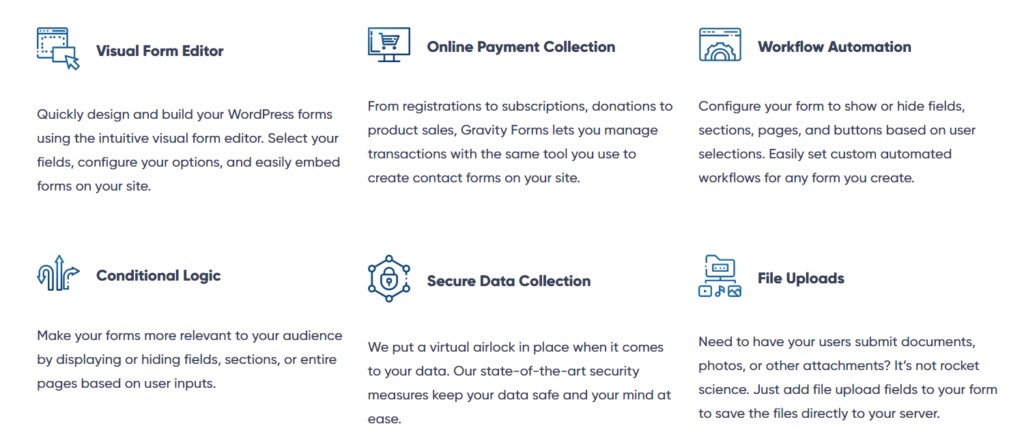
And my thoughts are supported by just about everything Gravity Forms offers. This popular alternative to Google Forms features live notifications, a form save tool, and a beginner-friendly visual editor.
Pros:
- Affordable
- Integrations with numerous third-party platforms
- Beginner-friendly Quickstart guide
Cons:
- No live chat or phone support
- Only works with WordPress
- Integrations can be difficult
Pricing plans:
There are three plans available, with licenses costing from $59 per year. Unfortunately, there’s no free-forever option or free trial.
| Basic | $59/year |
| Pro | $159/year |
| Elite | $259/year |
Why Gravity Forms is a good Google Forms competitor:
Although there are numerous sites like Google Forms that you can use to create forms and surveys, Gravity Forms is one of the best.
It’s an excellent option for WordPress users who want a simple, no-frills form builder backed by advanced features.
6. Microsoft Forms
- Website: https://www.microsoft.com/en-us/microsoft-365/online-surveys-polls-quizzes
- Part of the Microsoft ecosystem
- Simple yet effective all-around alternative
- Features built-in AI and smart recommendations
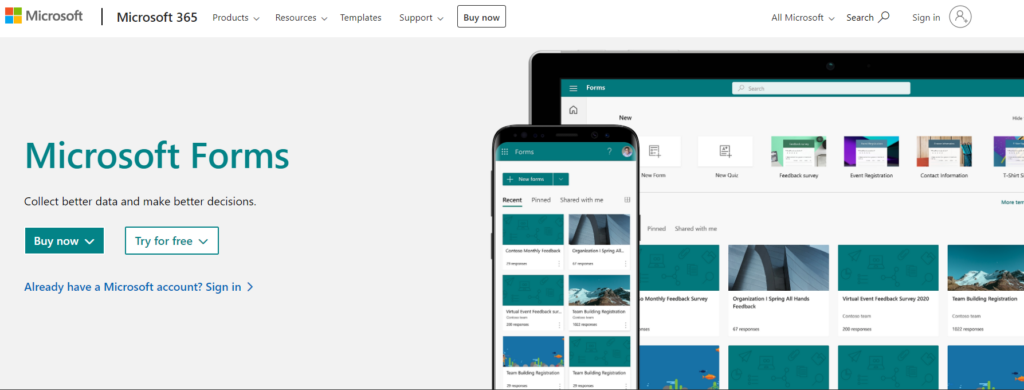
Microsoft Forms is a popular app from the larger Microsoft ecosystem. Although it isn’t nearly as powerful as many of the other options on this list, it’s a highly affordable choice.

And despite the lack of advanced features, there’s still a lot to like here. For example, you can use your forms to collect valuable business information, as part of the teaching process, and more.
The built-in AI tools are designed to streamline the form creation process, and you will be able to view results through the analysis portal.
Microsoft Forms pros:
- Impressive multilingual support
- Desktop and mobile support
- Very competitively priced
Microsoft Forms cons:
- Lacks many advanced features
- Limited collaboration tools
- Doesn’t the record form open without submission
Microsoft Forms pricing plans:
To access Microsoft Forms, you will need either an Office 365 Education or a Microsoft 365 Business subscription. It’s also available for those with a Hotmail, Live, or Outlook.com account.
Prices start from $5.00 per month with a Microsoft 365 Business Basic subscription, and there’s even a one-month free trial available.
Microsoft Forms vs Google Forms:
If you regularly work with the Microsoft ecosystem, Microsoft Forms could be an excellent alternative. With an existing Microsoft 365 subscription, you won’t even have to pay a cent!
7. 123 Form Builder
- Website: https://www.123formbuilder.com
- Excellent builder featuring numerous templates
- Huge range of third-party integrations
- Advanced data analysis and compilation portal
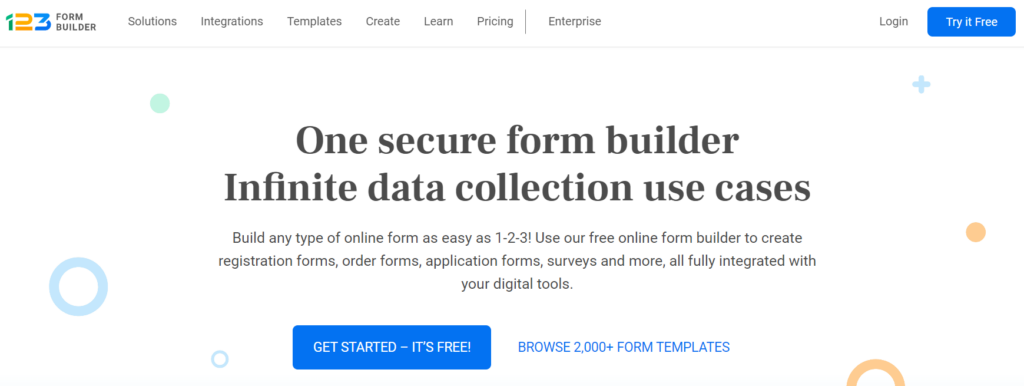
Although 123 Form Builder isn’t the most popular option on the market, it’s one that fully deserves its place on this list. I’ve used it a few times in the past, and I love virtually every aspect of its service.
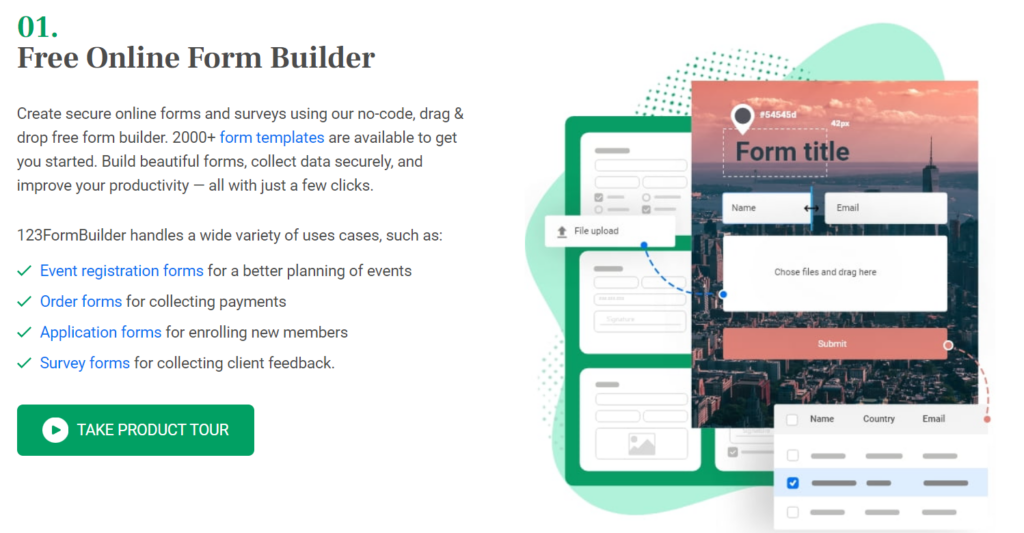
For starters, 123 Form Builder supports streamlined creation, allowing you to publish your first form within a few minutes.
But on top of this, you can also customize your design heavily with the drag-and-drop builder, spending as long as required to get it right.
123 Form Builder pros:
- Huge list of advanced integrations
- Multi-language forms supported
- Excellent drag-and-drop editor
123 Form Builder cons:
- Not all features are included with cheaper plans
- Some aspects of the builder can be confusing
- Constraining form limits
123 Form Builder pricing plans:
There is a Basic free-forever option, and enterprise-level custom solutions targeted at businesses of all sizes.
The free version is limited to 20 submissions per month, and premium options start at $19.99 per month.
| Individual | $19.99/month |
| Team | $49.99/month |
| Enterprise | From $199.99/year |
Why 123 Form Builder is a good alternative to Google Forms:
123 Form Builder is an excellent choice for those who want access to a vast array of integrations, a powerful builder, and a suite of features.
8. Formidable Forms
- Website: https://formidableforms.com
- A powerful form builder plugin for WordPress
- Beginner-friendly intuitive drag and drop builder
- Full HTML customizability is available
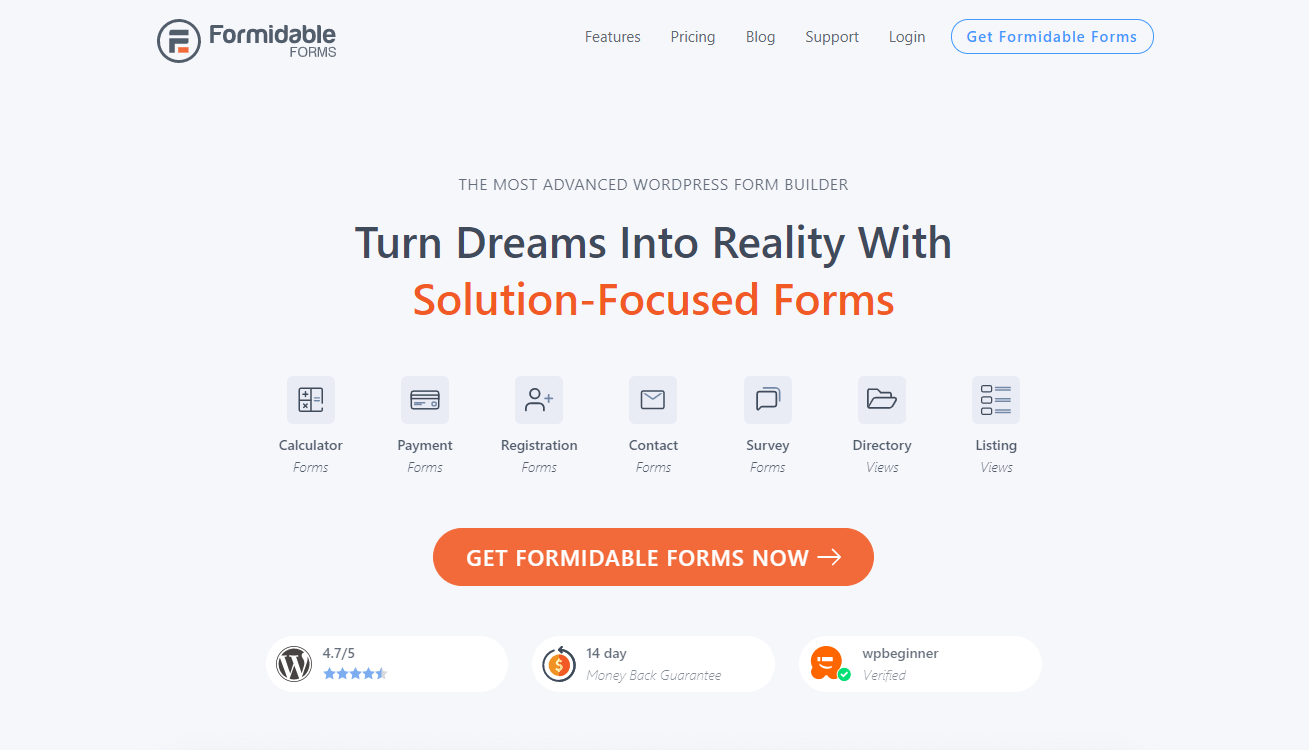
Formidable Forms is a powerful WordPress plugin designed for those who want to take their form-building one step further.
It’s backed by a suite of features, including full HTML code access for those with more advanced tech skills.

One thing I like about Formidable Forms is its excellent template library.
Along with the expected contact form and survey templates, you will find designs specifically for WooCommerce, payment collection, and more.
Pros:
- Excellent customizability across the board
- Full HTML code access
- Very easy to use
Cons:
- No community forum for support
- Some notable integrations are absent
- Can be confusing at times
Formidable Forms pricing plans:
If you would like to use this alternative, you can choose from one of the four premium plans.
All are backed by a 14-day money-back guarantee, and there’s even a separate free version available for download.
| Basic | $49.50/year |
| Plus | $99.50/year |
| Business | $199.50/year |
| Elite | $299.50/year |
Why Formidable Forms is a good alternative to Google Forms:
If you’re looking for a WordPress form builder that offers excellent design flexibility backed by competitive prices and a suite of advanced features, Formidable Forms is a great choice.
9. Zoho Forms
- Website: https://www.zoho.com/forms/
- Part of the extensive Zoho ecosystem
- Code-free form creation
- Powerful data analysis tools

Finding a powerful form builder that works for your business can be hard, but Zoho Forms brings a lot to the party.
I’ve used it a couple of times in the past, and I’ve found it to be intuitive yet powerful, a perfect combination for those with tight time constraints.

One thing that stands out to me here is the sheer power of Zoho Forms. The builder is among the best around, you can set up instant notifications, and the data analysis platform has to be seen to be believed.
Zoho Forms pros:
- Great data analysis tools
- Instant SMS or email notifications
- Impressive customization tools to add your company’s branding
Zoho Forms cons:
- Can be glitchy with low-end computers
- The template library could be better
- Some advanced features are missing
Zoho Forms pricing plans:
There is a free forever plan, but this is limited to 3 forms and 500 submissions per month. Paid options start from $10 per month, with a 20% discount available with annual payments.
Additional submissions can be purchased for $10 per month per 10,000, and additional storage is also available at $5 per 5GB.
| Basic | $10/month |
| Standard | $25/month |
| Professional | $50/month |
| Premium | $100/month |
Why Zoho Forms is a good alternative to Google Forms:
If you’re looking for an alternative to Google Forms that is powerful yet intuitive, I’d highly recommend taking a closer look at Zoho Forms.
What is Google Forms?

In short, Google Forms is a free platform that lets you put together customized forms for a range of uses. Websites like Google Forms have become increasingly popular tools for collecting and organizing data.
It’s a great option for those with basic needs, but it lacks the power of the competitor sites like Google Forms I’ve outlined on this list.
For example, it’s quite hard to personalize the appearance of a Google Form.
You will largely be constrained to the general template, which is far from ideal for those who want to add their own branding or create complex surveys or polls.
On top of this, integrations are limited, you won’t be able to accept payments, and many advanced features are absent altogether.
On the plus side, Google Forms comes with excellent collaboration features. As I noted above, it’s 100% free, forever, and it even comes with decent response collation and analysis tools.
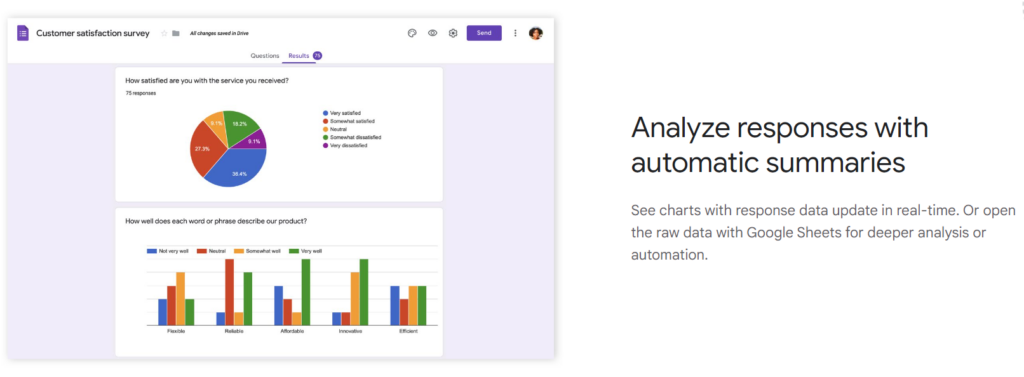
Google Forms features and pricing
Google Forms is 100% free, forever. Unlike many Google Forms competitors, you won’t ever have to pay for a premium plan or for more advanced features.
However, Business users might like to purchase a Google Workplace subscription to take advantage of powerful collaboration and security tools.
With purchase, you will also get additional Google Drive cloud storage, support from the Google team, and a secure business email account.
Google Workplace prices cost about $12 per user, per month, with Enterprise solutions available for high-end users.
Pros and cons of Google Forms
The standout for Google Forms is the fact that it’s completely free.
In my experience, few other free-form builders (if any) come even close to offering a similar level of service and versatility.
On the plus side, there are numerous templates available in various categories, including for education, personal use, and work use.
However, these are all quite simplistic and, at the end of the day, are really just the same thing with different input fields.
Another positive is the collaboration power of Google Forms. As with Google Docs, Sheets, or Slides, you can share your work with others by either sharing the link or inviting people with their email addresses.

Unfortunately, though, the builder itself is more than a little limited. It uses a block-based editing interface that allows you to basically add or remove fields, reorder elements, and change basic color schemes.
It lacks advanced security features such as reCAPTCHA, which means that it isn’t a great option for collecting sensitive data.
You won’t be able to take payments within the forms interface, and the layout can be more than a little illogical and unprofessional-looking at times.
Need to personalize things a little more? Forget about it.
Our Verdict ⭐
Google Forms is a serviceable option for creating basic forms without complex features or integrations. It’s quick, free, and gets the job done for simple surveys or data collection tasks.
However, after extensive testing, I’ve found its design options restrictive and its feature set lacking for professional use. For anything beyond the most basic forms, you’ll likely find yourself frustrated by its limitations.
While most Google Forms alternatives come with a price tag, the investment is typically minimal – often less than $10 per month for a robust solution. In my experience working with clients across various industries, this small cost pays dividends in terms of form functionality, user experience, and data analysis capabilities.
To put it in perspective, the cost of a premium form builder is often less than what you’d spend on coffee in a week. The time saved and improved results make it a worthwhile investment for most businesses and professionals.
After comparing numerous options, I’ve found Typeform to be the most versatile and user-friendly choice for a wide range of form-building needs. Its conversational format and sleek designs consistently lead to higher completion rates in my projects.
For those prioritizing design customization, JotForm offers unparalleled flexibility. I’ve used it to create forms that seamlessly match brand aesthetics. If budget is a primary concern, Wufoo provides solid functionality at a very competitive price point – it’s been my go-to recommendation for small businesses and startups.
WordPress users have several plugin options, but in my years of WordPress development, WPForms consistently outperforms the competition. Its intuitive interface and extensive feature set make it suitable for both beginners and advanced users.
While these are my top picks, the form builder market is diverse, with solutions catering to specific niches and use cases. I always recommend taking advantage of free trials and plans to test-drive different options. This hands-on approach has helped me and my clients find the perfect fit for various projects, from simple contact forms to complex multi-page surveys.
